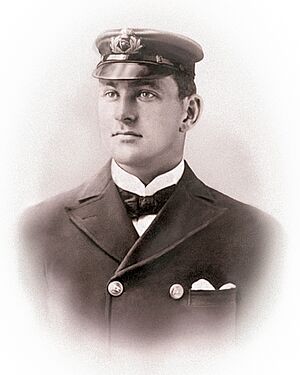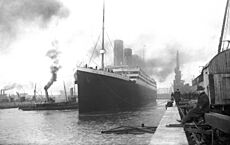Henry Tingle Wilde facts for kids
Quick facts for kids
Henry Tingle Wilde
|
|
|---|---|

Wilde in White Star Line uniform
|
|
| Born | 21 September 1872 Walton, England, UK |
| Died | 15 April 1912 (aged 39) North Atlantic Ocean |
| Buried | |
| Allegiance | |
| Service/ |
|
| Years of service | July 1897 - April 1912 |
| Rank | Lieutenant - Royal Naval Reserve |
| Spouse(s) |
Mary Catherine Jones
(m. 1898; died 1910) |
| Children | 6 |
Henry Tingle Wilde (born September 21, 1872 – died April 15, 1912) was a British naval officer. He was the chief officer on the famous RMS Titanic. He sadly died when the ship sank on its first trip in April 1912.
Early Life and Career
Henry Tingle Wilde was born in Walton, England, on September 21, 1872. His father, Henry Wilde, was an insurance surveyor. His mother was Elizabeth Tingle. Henry was also known as Harry by his friends.
He started working at sea when he was a teenager. He began an apprenticeship with Messrs. James Chambers & Co. in Liverpool. This training started on October 23, 1889, on a ship called the Greystoke Castle. He finished his apprenticeship four years later.
After his training, he worked as a third mate on the Greystoke Castle. Then he moved to another ship, the Hornsby Castle. In 1895, he joined his first steamship, the S.S. Brunswick. He worked there as a third mate and later as a second mate. In 1896, he became a second mate on the S.S. Europa.
In July 1897, Henry Wilde joined the White Star Line. This was a very famous shipping company. He quickly moved up in rank. He worked on many White Star ships, including the Covic, Cufic, Tauric, and Delphic. He also served on the Republic, Coptic, Majestic, Baltic, and Adriatic.
In December 1910, Wilde faced a very sad time. His wife and two baby sons died. He was left to care for his four other children. It was a difficult loss for him. Some people said he found it hard to get over this sadness.
In August 2011, Wilde became the Chief Officer of the RMS Olympic. This ship was the Titanic's sister ship. On the Olympic, he worked under Edward J. Smith. Captain Smith later became the captain of the Titanic.
Wilde was also an officer in the Royal Naval Reserve. He became a sub-lieutenant on June 26, 1902.
Service on the Titanic
Henry Wilde was supposed to sail on the Olympic from Southampton on April 3, 1912. However, there was a last-minute change for the Titanic. This change meant that William McMaster Murdoch and Charles Lightoller moved down a rank. David Blair, who was supposed to be Second Officer, was removed from the ship.
Wilde was then assigned to the Titanic voyage. He was a bit worried about this sudden change. But his friends told him it was a great chance he shouldn't miss. So, he accepted the job. Lightoller, another officer, described Wilde as a "big, powerful chap." Wilde officially joined the Titanic on the evening of April 9.
On April 10, 1912, the day the ship sailed, Wilde started his duty at 6:00 a.m. He helped with the ship's lifeboat drill. He was in charge of the front part of the ship, making sure the crew handled the ropes correctly. After the ship left port, Wilde worked the 2 a.m. to 6 a.m. and 2 p.m. to 6 p.m. watches every day.
On April 11, a steward named John E. Hart saw Wilde and the ship's designer, Thomas Andrews, checking the ship. They were making sure the crew could close the watertight doors by hand.
Wilde reportedly wrote a letter to his sister from Queenstown. In the letter, he said he had "a queer feeling about the ship."
The Sinking
On April 14, Wilde finished his watch at 6 p.m. At 11:40 p.m. that night, the Titanic hit an iceberg. After the crash, crew members noticed water flooding into the front of the ship. Wilde was told that the front hold was filling with water. He ordered the crew to get ready and prepare the lifeboats.
On the port (left) side of the ship, Wilde took charge of the lifeboats. Lightoller helped him. Wilde told Lightoller to remove the covers from the boats. He also asked if all the crew had been called to duty, and Wilde said yes.
During the evacuation, Wilde helped load several lifeboats. These included Lifeboats No. 8, 14, 12, 16, 2, and 10. While working, Wilde asked where the firearms were. He then gave a revolver and ammunition to Lightoller, saying he might need it. Wilde also said he was going to put on his life jacket.
By 1:40 a.m., most of the lifeboats on the port side were lowered. Wilde then moved to the starboard (right) side. He was seen helping women and children into Lifeboat No. 2. He also helped with Collapsible C. He made sure passengers got in and found crew members to manage the boat.
When some passengers from the lower decks started rushing the boats, Wilde pulled out his gun. He ordered the men to get out of the boat. He and Lightoller then told all passengers to go to the starboard side. This was to help balance the ship. Wilde told Lightoller to get into Lifeboat D, but Lightoller refused and stayed on the ship. This was the last time anyone reliably saw Wilde.
Death
An old newspaper article from May 1912 said that Wilde was last seen on the bridge. He was smoking a cigarette and waved goodbye to Lightoller as the ship sank. However, Lightoller himself never mentioned this. He only said he last saw Wilde "quite a long time before the ship went down."
Henry Wilde's body was never found.
Legacy
Henry Wilde's name is on a family tombstone at Kirkdale Cemetery in Liverpool. The stone says, "Also Captain Henry T. Wilde, RNR Acting Chief Officer Who Met His Death in the SS Titanic Disaster 15th April 1912 aged 38 years. 'One of Britain’s Heroes'".
Portrayals
- Howard Lang (1958) (A Night to Remember)
- Tony Caunter (1979) (S.O.S. Titanic)
- Mark Lindsay Chapman (1997) (Titanic)
- Will Keen (2012) (Titanic) (TV series/4 episodes)
See also
 In Spanish: Henry Wilde para niños
In Spanish: Henry Wilde para niños


